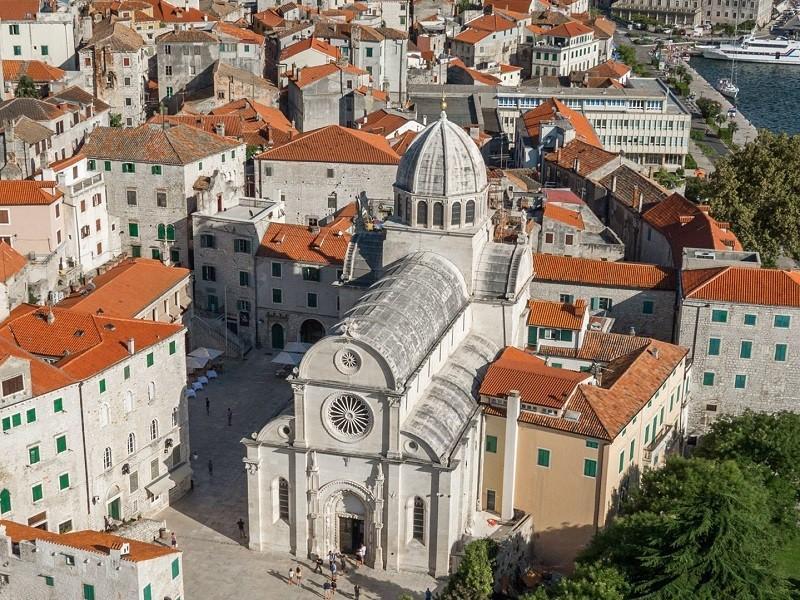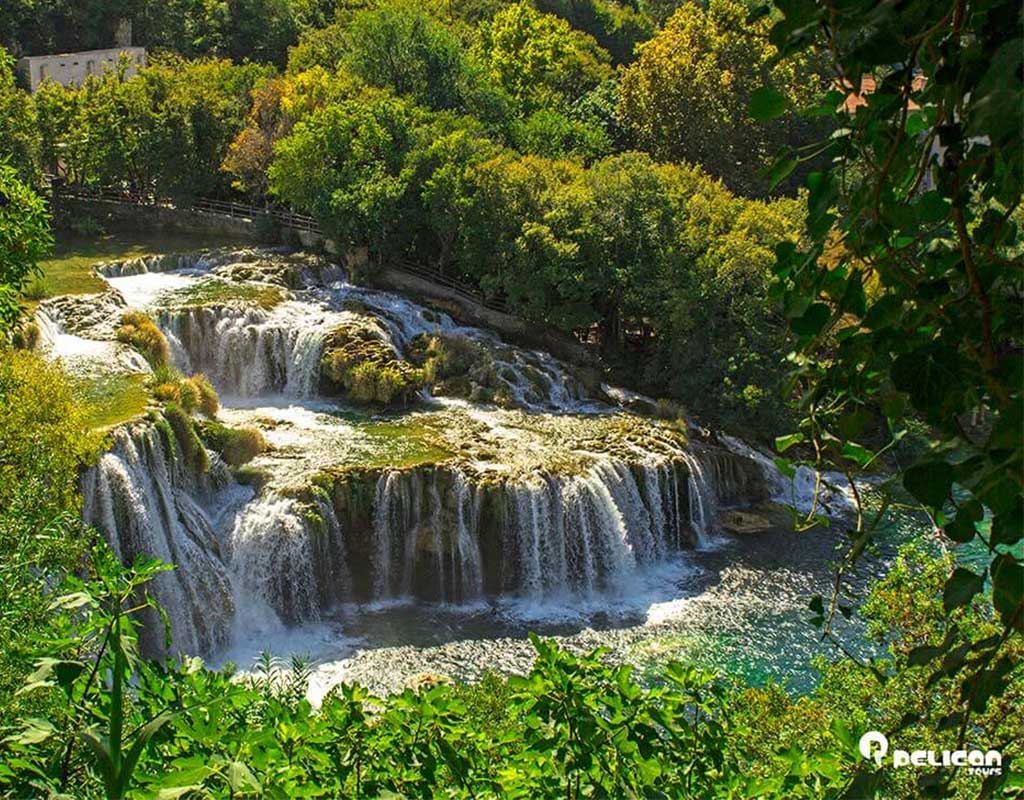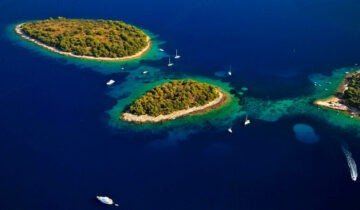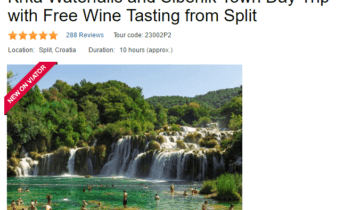In this article we are bringing you many interesting facts about Sibenik Croatia, so let’s start. Sibenik is situated in the central part of the Croatian Adriatic Coast, in the picturesque and indented bay where the Krka river one of the most beautiful Croatian rivers, enters the sea. Sibenik is a city with a population of approximately 37 000. Sibenik has a Mediterranean climate with mild winters and hot, dry summers. Today, Sibenik is an administrative, political, economical, social, and cultural center of the County of Sibenik and Knin, spreading over the 100-kilometer long coastline between the Zadar and Split Rivieras, and 45 kilometers of the Dinara mountain. Except that, this town is one of the most important sites which we are visiting on our Krka Waterfalls tour from Split.
General facts about Sibenik Croatia

You can reach the open sea and islands by the 300-1200 meter wide and 10 km long Sibenik Bay, through the narrow, winding channel. Although the coastal Sibenik area reaches only a few kilometers inland, to the Trtar mountain range and Mt. Svilaja on the Southeastern part, 66 % of all its population live here. After World War II, it underwent very rapid urbanization. Almost all manufacturing plants, business activities and economic forces of Sibenik County are concentrated here. This region is characterized by limestone mountain crests, small valleys (Gornje polje and Donje polje), and plateaus, which are the base for agriculture. Vegetation is mainly consisted sparse in the hinterland and maquis in the coastal areas and in the islands. Sibenik region has a Mediterranean climate with hot summers, cooled by the mistral and dry winters.
Sibenik, the oldest native Croatian city in the Adriatic, is located in the most protected natural harbor, in the center of the Eastern coast of the Adriatic Sea, at the mouth of the beautiful Krka River, at the very sources of Croatia’s abundant history. Probably, it was a place where some of the original Croatian settlers first saw the blue sea, as capricious as it is beautiful. Sea protected and defended them, fed and took care of them for as long as they could remember. Today, Sibenik has 47,274 inhabitants (2011.) and it is the capital, as well as the cultural, educational, administrative and economic center of the County of Sibenik and Knin.
History of Sibenik city

The harbor, connected to the open sea by St. Anthony Strait, has been an initiator of the town’s maritime affairs development, trading, and overall economic prosperity for centuries. At the entrance into the Strait, there is the fortress of St. Nicholas, the most important renaissance fortress on the Eastern coast of the Adriatic. Fortresses of St. Michael, St. John, and Subicevac surrounding the town represent a symbol of the centuries-old Sibenik’s continuous resistance. That fact was once more confirmed in the recent Croatian War of Independence.
Sibenik’s St. James’ Cathedral, built more than a century ago, represents the testimony of the persistence, sacrifice and beliefs of generations of Sibenik inhabitants. It is unique for many things – not only Croatian but also European architecture: it is built entirely of stone. Its uniqueness is in the use of stone slabs and ribs brave structures, built without using any binding materials. It is also distinguished by its trefoil front facade among Renaissance churches. Finally, it is unique in the harmony of its architecture and the series of 71 realistic sculptural portraits around the apses. The building of the cathedral among its Renaissance churches was continued with contributions from the entire community. Among them was a number of individuals too, including a large number of domestic stone-dressers, builders and artisans. The most important among them was Juraj Matejev Dalmatinac, originally from Zadar, who was commissioned by the town in 1441. as the protomaster of the Sibenik’s cathedral. The cathedral and the nearby Renaissance town hall, as well as the nearby churches, palaces and the Prince’s Palace presently housing the County Museum, probably represent Croatia’s Heritage most beautiful square.
Sites in Sibenik town

A must-see destination on the way to Krka waterfalls and Sibenik, especially if you are traveling from Split it’s the oldest Croatian town on the Adriatic coast – Šibenik.
The biggest treasures of art and architecture from Šibenik are dated back to the city’s golden era, which lasted from the end of the 14th to the middle of the 17th century. Among many different sites, there you can admire an impressive building, called also Šibenik’s Cathedral which was made in that period.
The cathedral of St James in Sibenik was being built from 1431 to 1536 and the construction was divided into three phases. The first phase was a bit clumsily led by masters of the Venetian Republic for around a decade, after which Juraj Matejev Dalmatinac (Giorgio Orsolani / George the Dalmatian) took over the construction, who was one of Europe’s greatest builders and artists of that time and gave the biggest contribution in an architectural and sculptural way.
Dalmatinac got his education in statuary and art in Venice, where he also mastered carpentry techniques which he daringly used during the assembly of the stone blocks. Stone is the only material used in the construction of the basilica, which actually makes this cathedral a unique example in the whole world.
Juraj Dalmatinac gave his contribution in many details, like friezes on the building’s apses with 71 portraits of his contemporaries, sculptures of St. Peter and St. Paul, located on the northern portal and, of course, the baptistery, a masterpiece of the Croatian sacral art.
What is more, a very interesting characteristic of this monumental building is the western trefoil apse followed by three barrel vaults of this three-nave basilica, which is contributed also to Nikola Firentinac (Niccola da Fiorenze), who continued the construction very successfully after Giorgio’s death in 1475. His other contributions include the beautiful sculpture of St. Michael (Mihovil) on the northern arch of transept, as well as the impressive, unique in the world, stone dome.
On the main western portal, you can see a depiction of 12 apostles, as well as an engraved lunette depicting the Last Judgment, work of the first master mason, Bonino da Milano which also did most of the northern “Lion Gate”. The bronze door wings on both entrances are the work of the local sculptor Grga Antunac.
On the sides of the main entrance, you can admire two sarcophagi, one of Ivan Lučić Štrafilič and the other one of bishop Juraj Šižgorić. Going further, on the left side there is the tomb of Bishop Srećko Badurina with the engravings by the sculptor Kazimir Hraste from 1997. On both sides along the apses, you can see numerous altars, dedicated to many saints and Gothic crucifixion by Juraj Petrović from 1455.
The main area for conducting the holy ceremonies has been raised because of the usual religious or customary practice and as an adjustment to the existing ground relief. In the niches, you can notice the depictions of prophets Elisha and Elijah. On top of the arch of the middle apse, there is a depiction of the Holy Father’s bust, a work of Niccola da Firenze, and in the sideway apses, there are engravings showing Christ and the dove of the Holy Spirit. The northern apse holds the organ, and the southern one holds the Renaissance wooden statue of St. Peter.
On the right is the baptistery, which itself is the most important work of art and architecture in this already magnificent masterpiece of a building. The baptistery in its base is a small, four-sided round room located beneath the floor of the southern apse. It is a must-see location in Sibenik city Croatia.
On the slightly curved vault, divided by Gothic decorations into 4 areas, Juraj Dalmatinac created an engraved image of the Holy Father and a dove of the Holy Spirit. They are surrounded by Renaissance archangels and heads of cherubs. In the middle of the room, there are three-winged cheerful boys, so-called Putti, who illuminate the way for the soul and carry baptismal well for the christening.
Due to all these merits, in the year 2000, UNESCO listed the cathedral of St James Sibenik on its list of World Heritage Sites and we highly recommend visiting this destination on our Private Krka Waterfalls tour!
The Sibenik City Museum – The Sibenik Museum was founded in 1925. in the name of the thousand-year anniversary of the Kingdom of Croatia. It is situated in the former Prince’s Palace, in the cathedral’s vicinity. The Sibenik City Museum is a complex type of museum. It consists of the archeological, cultural-historic and ethnographic departments. Its duties are collecting, preservation, elaboration and presentation of the Sibenik region’s cultural-historical heritage. Its collections consist of a number of valuable items, significant for the study of Sibenik’s history, from ancient times till the present days.
The Sacral Arts Museum – St. Barbara’s Church – The Museum of Sacral Arts is located in St. Barbara’s Church, near the Cathedral of St. James. The museum exhibition features, among other items, the triptych of St. Barbara with St. Nicolas and St. Grgur from the XVI century, as well as Renaissance stone statues of St. Peter and St. James on the sidewall of the cathedral of St. James. The display also includes the works of Oracio Fortezza, the great goldsmith, who worked in Sibenik.
Treasury of Benedictine nunnery of St. Luce – The Treasury collection contains religious objects for liturgical use, as well as paintings and sculptures. The most captivating part of the exhibition is a painted clay Madonna, dating from the XIII century. A stone inscription above the entrance honors XVII century benefactor Nikola Buronja, who donated three of his houses to help the monastery after its foundation.
Fortresses around Sibenik town

St. Michael Fortress – This fortress was built on top of the hill (70 m above the sea) in the Sibenik city center. It was mentioned for the first time in 998. It was destroyed several times (in powder-magazine explosions) and finally renovated in the XV century. Fortress enlargement was performed in the XVII and XVIII centuries. Today’s fortress was built of dressed stone during the period between XV and XVII century and it encompasses 2,600m².
The St. John Fortress – It was named after the chapel, situated at the same place. The fortress was built at the top of the hill (115 m above sea level) above the city. The citizens of Sibenik built it in only two months (in August and September of 1646.), according to the project of the Franciscan engineer Antonio Leni from Genoa. On his drawing, it has a shape of a star with built tongs towards the North. This fortress defended the city in a month-long siege against 20,000 Turks during fierce battles from August, 17th to September,16th 1647. (4,000 Turks died in those battles).
The Subicevac Fortress – It is situated on a hill (80 m above sea level), a bit lower than the St. John Fortress to the East. It was also built in 1646. for the same purpose – to defend the city against Turkish invaders. It’s a bit smaller but more accessible for visitors. Today, it provides a wonderful view of the city (there is an asphalt road through the forest, that goes to the fortress entrance) a specious harbor, channel and numerous islands.
Events in the city





Sibenik Travel info
By plane – Nearest airports are in Split (54 km) and in Zadar (67 km).
By bus – The bus station is just southeast of the city center on obala Hrvatske mornarice.
By car – Take the exit Sibenik on motorway A1 (Town Sibenik is 8 km far away from the motorway).
By ferry – The main coastal ferry doesn’t call at Sibenik, there are four daily departures to Vodice calling at the minor islands of Zlarin and Prvic.





 No products in the cart.
No products in the cart.